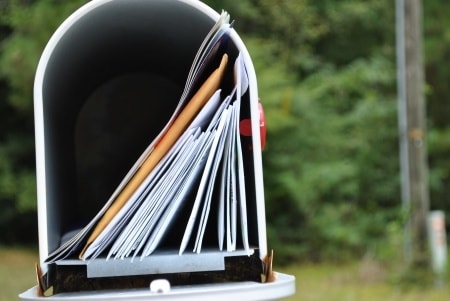 If you’ve recently noticed a new market that’s likely to be receptive to your products, services, or cause, you may be thinking that the cost of advertising is too high. Newspaper ads, television spots, radio commercials, and other traditional advertising methods are big investments that can take a while to bear fruit. Rather than take big risks right away, you can test this new market out quickly and relatively inexpensively by running a direct marketing campaign.
If you’ve recently noticed a new market that’s likely to be receptive to your products, services, or cause, you may be thinking that the cost of advertising is too high. Newspaper ads, television spots, radio commercials, and other traditional advertising methods are big investments that can take a while to bear fruit. Rather than take big risks right away, you can test this new market out quickly and relatively inexpensively by running a direct marketing campaign.
One of the more common ways to conduct a direct marketing campaign is to create your own list of targets; however, many organizations prefer to purchase existing lists from direct marketing companies. If you’re a large company, this gives you the opportunity to target defined markets with specialized information or incentives. Smaller organizations may want to take advantage of direct marketing as well, because you then can:
- Precisely target your recipients
- Protect your reputation against an overwhelming response
- Work within a relatively small budget
- Get quick results
- Modify your approach according to results
If you’re trying to sell a new product or service, direct mailers provide an easy method for your customers to place an order from the comfort of their own homes or businesses. For B2B companies, the first mailer plays a crucial step in the lead generating process. After receiving an enticing mailer, a new client may request more information in the form of a brochure or catalog. These first few steps can be combined with other forms of contact, perhaps through email or phone, to help convert your potential client into a tangible sale.
Finding Targets for Your Direct Mailing Campaign
 Let’s take a look at how the first step of your direct marketing campaign can work with an example company: a small catering company. Your catering business has been operating for about five years, and you have a few dozen regular clients as well as sporadic events that fill your schedule. Your regular clients are mostly medium sized local businesses with 15 to 50 employees. You don’t have the cooking capacity yet for larger clients, and smaller orders simply aren’t part of your business model. Many new tech companies are opening up in the area that fit your business model, so your goal is to grab the attention of these companies and start catering for them.
Let’s take a look at how the first step of your direct marketing campaign can work with an example company: a small catering company. Your catering business has been operating for about five years, and you have a few dozen regular clients as well as sporadic events that fill your schedule. Your regular clients are mostly medium sized local businesses with 15 to 50 employees. You don’t have the cooking capacity yet for larger clients, and smaller orders simply aren’t part of your business model. Many new tech companies are opening up in the area that fit your business model, so your goal is to grab the attention of these companies and start catering for them.
There are several approaches to reaching your goal here. One is to make sure you send mailers to your existing clients because referrals and recommendations are always a powerful tool. You can encourage your clients to spread word about your catering services by providing incentives for recommendations in your direct marketing campaign. This can include discounts, loyalty rewards and other benefits. Next, get a list of new or unknown businesses in your area. You can do this by joining local business organizations, discovering new licenses through government organizations, or by getting a list from a local direct mailing company.
Implementing Your Campaign
Once you’ve established your goals and which targets can help you succeed, it’s time to start working on the nuts and bolts of your campaign. This involves seven unique steps:
- Finalize your mailing list. Once you’ve figured out the right targets for your campaign, you’ll need to list them out so that you can create labels. The format you use will depend on the type of mailer you use and the size of your campaign. If you use a list provider, they will most likely provide labels for you. Experts believe that 40 percent of the impact of your campaign will come from having the right list.
- Create your mailer. Whether you want to create a postcard or a leaflet, your mailers should make your brand look appealing, and they should always include a call to action. For your catering company, you may want to include a link to your online menu and a phone number where one of your employees can provide additional information. Choose a mailer for your direct marketing campaign that’s appropriate for the goals you have.
- Create unique identifiers. One of the most important parts of your campaign will be keeping track of your results. That’s why your mailers should have a unique code, like a number, that helps you figure out which pieces worked and which didn’t. All you have to do is have your targets provide this identifier when responding to your mailer.
- Test your campaign. Even the cheapest type of mail campaign can have a sizeable budget, so you’ll want to test things out before sending mailers to your full list. A good guideline for a test is 10 percent of your full list. If things go smoothly and you get good results, you can move forward with the full campaign.
- Run your campaign at the right speed. Your test run will give you a good idea how many responses you’re likely to get, so use that number to send out an amount of mailers that your company can keep up with. If you get too many responses and can’t fulfill demand, your reputation with the business community is likely to suffer.
- Process your customer responses. Once your targets start visiting your website and scheduling events, you need to make sure your team is ready to provide the high level of service you’ve worked hard to build. Your hypothetical catering company should be ready to handle a business lunch at a new client within a day.
- Analyze your results. Combine the information you’ve gleaned from your unique identifiers along with sales figures and customer feedback to figure out how successful your first campaign went. As you send out more mailers and get more responses, you’ll find the ability to get the results you want a whole lot easier.
Choosing the Right Mailer
 Creating your mailer was briefly mentioned in the last section, but choosing the right mailer for your campaign can seem confusing for many companies. The option that’s right for your campaign will depend on what your company does and what kind of goals you have. In the case of the catering company, a short flier with a few menu options alongside some delectable pictures can be enough to get businesses to respond. That approach wouldn’t likely work for a travel agency or cleaning company.
Creating your mailer was briefly mentioned in the last section, but choosing the right mailer for your campaign can seem confusing for many companies. The option that’s right for your campaign will depend on what your company does and what kind of goals you have. In the case of the catering company, a short flier with a few menu options alongside some delectable pictures can be enough to get businesses to respond. That approach wouldn’t likely work for a travel agency or cleaning company.
Postcards are a great choice if you’re planning your first direct marketing campaign. They’re cheap, concise, and can be an important first step in your lead generation process. Unlike many other forms of mailers, postcards have no barrier to entry. As soon as your recipient picks your postcard up from the mail, they’ll see your message immediately. This can be useful for grabbing the attention of busy secretaries or bosses who would otherwise throw marketing materials in the trash.
The sales letter is one of the oldest and most well known forms of mail advertising for direct marketing campaigns. Your letter should be personalized for your recipient and written in a professional manner. It should include something of value for the target as well as a call to action so that the client has clear instructions if they show interest. Add deadlines to your offers to get people to respond immediately. These letters often include envelopes and reply cards.
Self-mailers are a cost-effective, all-in-one direct mailing option that can meet a wide range of needs. The internal structure of a self-mailer can include up to four panels with anything from new products to official campaign events.Three panel self-mailers are really common for local restaurants that put their menus on your car windshield or front door. Self-mailers sometimes have a cheap look that’s indicative of a lot of junk mail, but you can overcome this challenge by having good design.
Newsletters are a powerful tool for keeping in touch with existing clients. For example, your catering company could release a monthly newsletter that details new menu options and exciting events your company has recently catered. By keeping in touch on a regular basis, you’ll stay in your clients’ minds when it comes time for them to find your products or services.
Ongoing Success with Your Direct Marketing Campaign
If you’re like most companies and get good results with your mailers, you’ll want to continue sending out new pieces indefinitely. It’s important not to get stale with your strategy over time as markets change and people develop different styles and tastes. What may work really well one month may have poor results the next. As long as you adapt to changing conditions, you’ll continue to find success with your direct marketing campaign.








